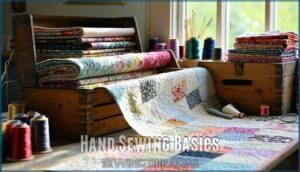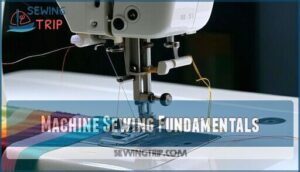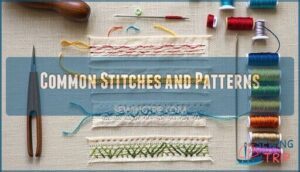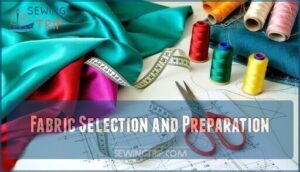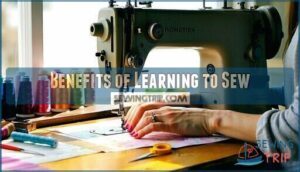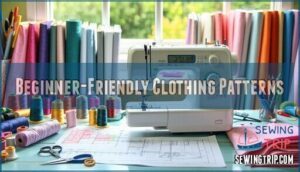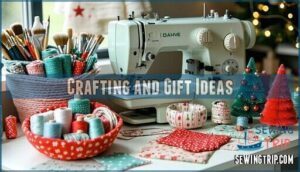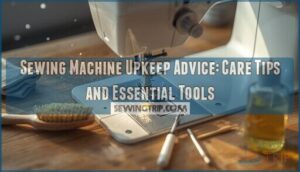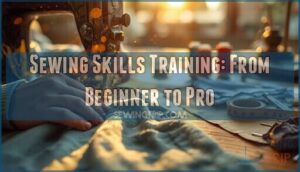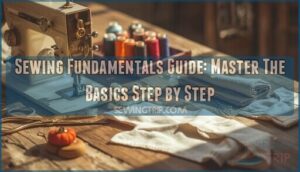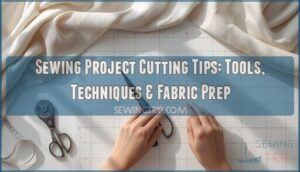This site is supported by our readers. We may earn a commission, at no cost to you, if you purchase through links.

You’re mastering technical precision when you line up seams, creative problem-solving when you adapt patterns, and hands-on craftsmanship that screens can’t replicate.
Think of it as your personal superpower that combines art with engineering.
Every stitch builds patience, sharpens attention to detail, and strengthens problem-solving muscles you’ll use everywhere.
Plus, you’re joining a vibrant community that’s revolutionizing how we share knowledge and challenge fast fashion through social media and online activism.
The real magic happens when technical mastery meets creative brilliance—and that’s where things get interesting, combining art with engineering in a unique way.
Table Of Contents
Key Takeaways
- You’ll develop technical precision and problem-solving skills – Sewing teaches you to line up seams perfectly, adapt patterns creatively, and troubleshoot construction challenges that strengthen your attention to detail.
- You can save money while supporting sustainability – Learning to repair, alter, and create your own clothing cuts costs significantly while reducing fast fashion’s environmental impact through fabric recycling and upcycling.
- You’ll gain a valuable creative outlet with practical benefits – Sewing combines artistic expression with hands-on craftsmanship, letting you create custom pieces that reflect your personal style while building confidence.
- You can turn your hobby into income – Your sewing skills are marketable through Etsy shops, custom alterations, teaching classes, or upcycling services in your community.
Is Sewing Considered a Skill?
You might wonder if sewing counts as a real skill in today’s digital world.
The answer is absolutely yes—sewing combines technical precision, creative problem-solving, and hands-on craftsmanship that’s more valuable than ever, with creative problem-solving being a key aspect of its value.
Sewing isn’t just a hobby—it’s technical mastery meeting creative brilliance in every stitch
Digital Privacy Best Practices
How do you protect your digital footprint while sharing sewing projects online? Your creative work deserves privacy protection just like your personal data.
When joining sewing classes or connecting with the sewing community online, safeguarding your information becomes essential:
- Data Encryption – Use secure platforms for sewing education and instruction sharing
- Privacy Settings – Limit who sees your project photos and personal details
- Cyber Security – Verify sewing community websites before sharing contact information
Understanding sewing advice blog resources can help you make informed decisions about online privacy.
Your Digital Rights matter in creative spaces too.
Emerging Social Media Trends
You’ve witnessed sewing tutorials explode across TikTok and Instagram, transforming humble fabric scraps into viral content.
Influencer Marketing now features sewing creators partnering with fabric brands, while Social Commerce lets you shop patterns directly through posts.
Content Creation in the sewing community drives massive engagement, with Online Communities fostering sewing education through live tutorials and sewing classes.
| Platform | Content Type | Community Impact |
|---|---|---|
| TikTok | Quick tutorials | Viral sewing hacks |
| Progress photos | Pattern sharing | |
| YouTube | Deep-dive classes | Expert instruction |
| Project inspiration | Creative expression | |
| Community groups | Troubleshooting help |
Digital Storytelling transforms simple sewing instruction into compelling narratives that inspire millions to pick up needles and thread.
Impact of Online Activism
You’ve witnessed sewing communities unite through social media platforms, transforming craft circles into powerful virtual movements.
Online activism within sewing spaces addresses digital rights, promotes sustainable fashion, and challenges fast-fashion practices through cyber activism.
Sewing tutorials and classes now carry messages about ethical consumption, while virtual movements encourage skill-sharing that builds community resilience.
Essential Sewing Skills and Techniques
Building strong sewing fundamentals starts with mastering the four core areas that’ll turn you from fumbling with fabric to creating beautiful pieces confidently.
Once you’ve got hand stitching, machine basics, essential stitches, and fabric prep down pat, you’ll tackle any project like a pro.
Hand Sewing Basics
Mastering hand sewing opens up creative freedom through essential needle techniques and fabric handling skills.
You’ll learn basic straight stitch, running stitch, and backstitch—fundamental hand stitches every beginner needs.
Proper thread management prevents tangles, while quality sewing notions like sharp scissors and thimbles make stitching smoother.
This beginner’s guide transforms intimidating projects into achievable victories.
Understanding hand sewing techniques is vital for any sewist to improve their skills.
Machine Sewing Fundamentals
Machine sewing transforms your crafting game once you’ve got hand stitches down.
Your sewing machine becomes a powerful ally when you master Thread Tension adjustments and Bobbin Management.
Set your Stitch Length between 2.0-2.5mm for most projects, and let the Fabric Feed guide material smoothly.
These sewing techniques form the backbone of successful machine guidance and sewing lessons.
Understanding proper sewing machine maintenance is vital for peak performance.
Common Stitches and Patterns
Essential sewing stitches reveal your creative potential.
The Running Stitch creates quick seams, while the Backstitch provides durability for stress points.
You’ll use the Whipstitch for clean hems and the Zigzag Stitch for stretchy fabrics.
These Hand Sewing Basics form your foundation—master them, and you’ll tackle any sewing patterns with confidence and precision.
Fabric Selection and Preparation
Beyond mastering stitches, you’ll need to choose the right materials for your projects. Smart fabric selection sets you up for sewing success, while proper preparation prevents costly mistakes down the road.
Understanding sewing fabric types is vital for achieving professional results.
Key fabric preparation steps:
- Prewash your fabric – This prevents shrinkage surprises after you’ve finished your masterpiece
- Iron out wrinkles – Smooth fabric guarantees accurate cutting and professional-looking seams
- Match thread colors carefully – Your stitching should blend seamlessly with your chosen textile
- Consider fabric weight – Heavy denim requires different techniques than delicate silk
Benefits of Learning to Sew
You’ll discover remarkable personal growth through sewing that extends far beyond creating beautiful handmade items.
Learning to sew develops patience, attention to detail, and problem-solving skills while offering creative self-expression and practical money-saving benefits, which also contributes to personal growth.
Creative Self-Expression
When you pick up fabric and thread, you’re not just learning techniques—you’re discovering your creative journey.
Every stitch you make writes your unique creative story into fabric and thread
Sewing for beginners offers the ultimate creative outlet, letting you break free from fashion trends and develop your personal style.
Through artistic freedom and sewing tips and tricks, you’ll discover that transforms ordinary materials into extraordinary pieces reflecting your unique vision and personality.
Clothing Repair and Alteration
Garment mending transforms worn-out favorites into wardrobe staples again.
You’ll master hemming pants for perfect lengths, tackle zipper repair without replacing entire pieces, and learn garment refitting techniques that make clothes fit like they’re custom-made.
Fabric patching covers holes creatively while alteration techniques extend clothing lifespans substantially, making these sewing skills invaluable.
Mastering sewing machine basics is essential for achieving professional results in clothing repair and alteration, and is a key part of garment refitting and fabric patching techniques that help with clothing repair.
Cost Savings and Sustainability
Your wallet and the planet thank you for choosing sewing over shopping.
With sewing supplies seeing virtually no inflation since 1997, you’re looking at serious savings.
Eco friendly practices like fabric recycling and using repurposed textiles slash costs further.
Green sewing with sustainable materials cuts your clothing budget while reducing fast fashion’s environmental impact—it’s a win-win.
By adopting eco friendly methods, sewers can make a significant positive impact on the environment.
Emotional Well-Being and Patience
Sewing isn’t just about creating beautiful pieces—it’s your secret weapon for mental health and emotional balance.
When you’re stitching, you’re practicing mindfulness without realizing it.
- Stress relief through repetitive, meditative motions
- Self care that builds confidence with each completed project
- Creative support that channels anxious energy productively
Sewing tutorials for beginners offer more than techniques—they’re pathways to patience and inner peace.
Sewing Projects for Skill Development
The best way to develop your sewing skills is by working on projects that gradually challenge your abilities while building confidence.
You’ll start with simple beginner patterns like pajama pants and progress to more complex items like structured bags, each project teaching new techniques that layer upon your growing foundation.
Beginner-Friendly Clothing Patterns
Starting with three essential garments opens your sewing journey perfectly. Pajama Pants and Kids Leggings teach elastic waistbands, while Easy Dresses introduce bias binding.
These Simple Sewing Projects build confidence through success. Understanding various sewing patterns is essential for selecting the right project.
| Pattern Type | Key Skills Learned |
|---|---|
| Pajama Pants | Elastic waistband, straight seams |
| Kids Leggings | Stretch fabric handling, hemming |
| Flannel Poncho | Basic cutting, minimal construction |
| Easy Dresses | Bias binding, simple shaping |
These Beginner Friendly Sewing patterns avoid zippers and buttonholes—your future self will thank you for mastering basics first.
DIY Home Decor and Organization
Your home deserves the same attention you give your wardrobe.
Transform your space with DIY Home Decor sewing projects that tackle Storage Solutions and Home Organization simultaneously.
Create reversible table runners, foldable organizing bins, and bedside pocket organizers that blend Room Decor with functionality.
These sewing tutorials for beginners prove that effective Space Planning starts with clever fabric choices and smart Decor Patterns.
Crafting and Gift Ideas
Your creativity’s canvas expands beyond clothing when you tackle Fabric Crafts and Handmade Gifts.
These DIY Sewing Projects transform scraps into treasured keepsakes, making Gift Wrapping unnecessary since the creation itself becomes the present.
Three heartwarming sewing ideas for home:
- Rope bowls using fabric scraps – Turn remnants into functional art
- Christmas tree potholders – Seasonal charm that’s actually useful
- Microwave bowl cozies – Practical gifts everyone secretly needs
Sewing for Kids and Families
When kids discover the magic of stitching their first pillow or simple tote bag, you’re watching future makers bloom.
Family crafts become bonding adventures as parent-child teams tackle beginner sewing projects together.
Start with easy sewing patterns for kids like the adorable Simple Cat Softie—it’s foolproof and builds confidence quickly.
These DIY projects teach patience while creating treasured keepsakes everyone’ll cherish.
Advancing Your Sewing Abilities
Once you’ve mastered basic techniques, it’s time to challenge yourself with advanced projects that’ll stretch your skills and spark your creativity.
From taking specialized classes to exploring fashion design, these next steps will transform you from a hobby sewer into a true craftsperson.
Continuing Education and Tutorials
Mastery doesn’t stop at your first finished project.
Over 120 accredited sewing courses and countless online tutorials await your next breakthrough.
YouTube channels with millions of subscribers offer step-by-step guidance, while platforms like Craftsy provide structured sewing lessons for under $10 monthly.
These skill builders transform hobbyists into confident creators through practice-focused learning to sew.
Joining The Sewing Community
Looking for support and inspiration? The sewing community welcomes you with open arms through Sewing Groups, Online Forums, and Community Events.
Join Sewing Classes at your local community classroom or connect through Sewing Blogs featuring Member Spotlight stories.
The quilting community offers specialized Sewing Courses, while online spaces provide 24/7 encouragement. You’ll find mentors, troubleshoot problems, and celebrate victories together.
Many sewers also find inspiration from a helpful sewing advice blog.
Exploring Fashion Design and Customization
Once you’ve connected with fellow sewers, you’re ready to bring out your creative vision through Fashion Design and custom garments.
Pattern Alteration becomes your playground—transforming basic templates into unique pieces that reflect your personal style.
Design Inspiration strikes everywhere, from vintage finds to modern streetwear.
Upcycling Clothes breathes new life into forgotten garments, while Textile Art techniques add distinctive flair to your creations.
Turning Sewing Into a Marketable Skill
Your sewing expertise can become a profitable business venture.
Start an Etsy shop selling handmade items or digital pattern designs.
Offer custom alterations in your community—they’re always in demand.
Teaching classes builds recurring income while sharing your passion.
Focus on upcycling clothing for eco-conscious customers.
Your skill advancement transforms hobby into career.
Frequently Asked Questions (FAQs)
How can sewing contribute to environmental sustainability?
You’ll reduce waste by repairing clothes instead of tossing them, upcycling old fabrics into new treasures, and creating durable items that last years longer than fast fashion.
What are some common tools and materials used in sewing?
You’ll need basic tools like needles, thread, scissors, pins, and measuring tape. Essential materials include fabric, interfacing, zippers, buttons, and elastic for waistbands and seams.
How does sewing promote individual creativity and self-expression?
Ever wanted to stitch up a wild idea?
With a needle and fabric, you shape anything you dream up—funky clothes, clever bags, wild color combos.
Your hands become your paintbrush, turning plain fabric into personal art.
What are the key differences between sewing and dressmaking?
When you’re crafting garments, you’re diving into dressmaking – the specialized art of creating fitted clothing with precise measurements, pattern alterations, and construction techniques.
That transform basic sewing into wearable artistry.
Why is learning dressmaking important for creating tailored clothing?
While basic sewing creates functional items, you’ll discover dressmaking transforms fabric into perfectly fitted garments.
You’ll master precise measurements, dart placement, and complex construction techniques that guarantee your clothes flatter your unique body shape beautifully.
What sewing tools do beginners need first?
You’ll need sharp fabric scissors, a seam ripper for fixing mistakes, measuring tape, straight pins, and hand-sewing needles in various sizes. Start with these essentials before investing in machines.
How long does it take to learn?
Like learning to ride a bike, you’ll wobble at first but find your rhythm quickly.
Basic hand stitches take days to master, simple projects weeks, and solid skills develop within months of consistent practice.
Can you learn sewing without classes?
You can teach yourself sewing using online tutorials, YouTube videos, books, and practice.
Start with simple projects like pillowcases or tote bags, then gradually tackle more complex techniques as your confidence grows.
Whats the difference between hand and machine?
Hand sewing gives you complete control and portability—you can stitch anywhere with just needle and thread.
Machine sewing’s faster and handles thick fabrics better, but you’re tied to your workspace.
Is sewing harder than other crafts?
Sewing isn’t necessarily harder than other crafts—it’s more like learning to dance with fabric.
You’ll master basic stitches quickly, but perfecting techniques takes practice, just like any worthwhile skill worth pursuing.
Conclusion
Ironically, while our world obsesses over digital skills, sewing—this ancient craft—has become more relevant than ever.
You’re not just threading needles; you’re developing critical thinking, precision, and creativity that algorithms can’t replicate.
Whether you’re mending a favorite shirt or crafting custom pieces, is sewing a skill? Absolutely.
It’s your gateway to sustainable living, mindful making, and joining a community that values quality over quantity.
Start stitching today and discover the benefits of mindful making.
- https://www.textileschool.com/304/hand-stitch-types/
- https://www.reddit.com/r/HandSew/comments/1agb422/best_stitches_to_learn_for_hand_sewing/
- https://cutesycrafts.com/2022/05/how-to-sew-6-easy-steps-for-beginners.html
- https://siemachtsewingblog.com/2022/12/hand-sewing-techniques/
- https://thedreamstress.com/2013/03/tips-and-tricks-for-hand-sewing-historical-and-otherwise/

